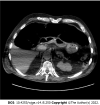Percutaneous endoscopic gastrostomy and jejunostomy: Indications and techniques
- PMID: 35719902
- PMCID: PMC9157691
- DOI: 10.4253/wjge.v14.i5.250
Percutaneous endoscopic gastrostomy and jejunostomy: Indications and techniques
Abstract
Nutritional support is essential in patients who have a limited capability to maintain their body weight. Therefore, oral feeding is the main approach for such patients. When physiological nutrition is not possible, positioning of a nasogastric, nasojejunal tube, or other percutaneous devices may be feasible alternatives. Creating a percutaneous endoscopic gastrostomy (PEG) is a suitable option to be evaluated for patients that need nutritional support for more than 4 wk. Many diseases require nutritional support by PEG, with neurological, oncological, and catabolic diseases being the most common. PEG can be performed endoscopically by various techniques, radiologically or surgically, with different outcomes and related adverse events (AEs). Moreover, some patients that need a PEG placement are fragile and are unable to express their will or sign a written informed consent. These conditions highlight many ethical problems that become difficult to manage as treatment progresses. The aim of this manuscript is to review all current endoscopic techniques for percutaneous access, their indications, postprocedural follow-up, and AEs.
Keywords: Enteral nutrition; Gastrostomy; Indications and techniques; Percutaneous endoscopic gastrostomy; Percutaneous endoscopic jejunostomy.
©The Author(s) 2022. Published by Baishideng Publishing Group Inc. All rights reserved.
Conflict of interest statement
Conflict-of-interest statement: All the authors declare that they have no competing interests related to the topic.
Figures








Similar articles
-
Comparison of laparoscopic jejunostomy tube to percutaneous endoscopic gastrostomy tube with jejunal extension: long-term durability and nutritional outcomes.Surg Endosc. 2018 May;32(5):2496-2504. doi: 10.1007/s00464-017-5954-6. Epub 2017 Dec 7. Surg Endosc. 2018. PMID: 29218657
-
A survey of the reasons patients do not chose percutaneous endoscopic gastrostomy/jejunostomy (PEG/PEJ) as a route for long-term feeding.J Clin Nurs. 2011 Mar;20(5-6):802-10. doi: 10.1111/j.1365-2702.2010.03541.x. J Clin Nurs. 2011. PMID: 21320205
-
Percutaneous endoscopic gastrostomy: indications, technique, complications and management.World J Gastroenterol. 2014 Jun 28;20(24):7739-51. doi: 10.3748/wjg.v20.i24.7739. World J Gastroenterol. 2014. PMID: 24976711 Free PMC article. Review.
-
Postpyloric enteral feeding costs for patients with severe head injury: blind placement, endoscopy, and PEG/J versus TPN.J Neurotrauma. 1999 Mar;16(3):233-42. doi: 10.1089/neu.1999.16.233. J Neurotrauma. 1999. PMID: 10195471 Clinical Trial.
-
Enteral nutrition delivery technique.Curr Opin Clin Nutr Metab Care. 2003 May;6(3):313-7. doi: 10.1097/01.mco.0000068968.34812.14. Curr Opin Clin Nutr Metab Care. 2003. PMID: 12690265 Review.
Cited by
-
Complications of gastrostomy tube placement in patients with dementia: a national inpatient analysis.Surg Endosc. 2025 Aug;39(8):5001-5007. doi: 10.1007/s00464-025-11923-x. Epub 2025 Jun 30. Surg Endosc. 2025. PMID: 40588598
-
Outcomes of lung transplantation for scleroderma versus other indications: Insigts from a single center.JHLT Open. 2025 Apr 4;8:100266. doi: 10.1016/j.jhlto.2025.100266. eCollection 2025 May. JHLT Open. 2025. PMID: 40330662 Free PMC article.
-
Retrograde Migration of a Percutaneous Endoscopic Gastro-Jejunal Tube Into the Esophagus.Cureus. 2024 Jan 11;16(1):e52105. doi: 10.7759/cureus.52105. eCollection 2024 Jan. Cureus. 2024. PMID: 38344502 Free PMC article.
-
Retrograde transgastric jejunostomy for nutritional management and aspiration prevention in cases with severe malignant esophageal strictures.DEN Open. 2023 Nov 20;4(1):e321. doi: 10.1002/deo2.321. eCollection 2024 Apr. DEN Open. 2023. PMID: 38023668 Free PMC article.
-
The Impact of Immunomodulatory Components Used in Clinical Nutrition-A Narrative Review.Nutrients. 2025 Feb 21;17(5):752. doi: 10.3390/nu17050752. Nutrients. 2025. PMID: 40077622 Free PMC article. Review.
References
-
- Welbank T, Kurien M. To PEG or not to PEG that is the question. Proc Nutr Soc. 2021;80:1–8. - PubMed
-
- Kurien M, Penny H, Sanders DS. Impact of direct drug delivery via gastric access devices. Expert Opin Drug Deliv. 2015;12:455–463. - PubMed
-
- Arvanitakis M, Gkolfakis P, Despott EJ, Ballarin A, Beyna T, Boeykens K, Elbe P, Gisbertz I, Hoyois A, Mosteanu O, Sanders DS, Schmidt PT, Schneider SM, van Hooft JE. Endoscopic management of enteral tubes in adult patients - Part 1: Definitions and indications. European Society of Gastrointestinal Endoscopy (ESGE) Guideline. Endoscopy. 2021;53:81–92. - PubMed
-
- Buchman AL, Moukarzel AA, Bhuta S, Belle M, Ament ME, Eckhert CD, Hollander D, Gornbein J, Kopple JD, Vijayaroghavan SR. Parenteral nutrition is associated with intestinal morphologic and functional changes in humans. JPEN J Parenter Enteral Nutr. 1995;19:453–460. - PubMed
-
- Braunschweig CL, Levy P, Sheean PM, Wang X. Enteral compared with parenteral nutrition: a meta-analysis. Am J Clin Nutr. 2001;74:534–542. - PubMed
Publication types
LinkOut - more resources
Full Text Sources

